Key takeaways:
- Gender equality advocacy aims to dismantle systemic barriers and change mindsets for equitable opportunities and access.
- Personal storytelling and collaboration with diverse groups are crucial strategies for effective advocacy and fostering understanding.
- Building supportive communities is essential for creating safe spaces for healing and empowerment among advocates.
- Measuring impact through data and personal narratives helps assess the effectiveness of advocacy efforts and connect with audiences.
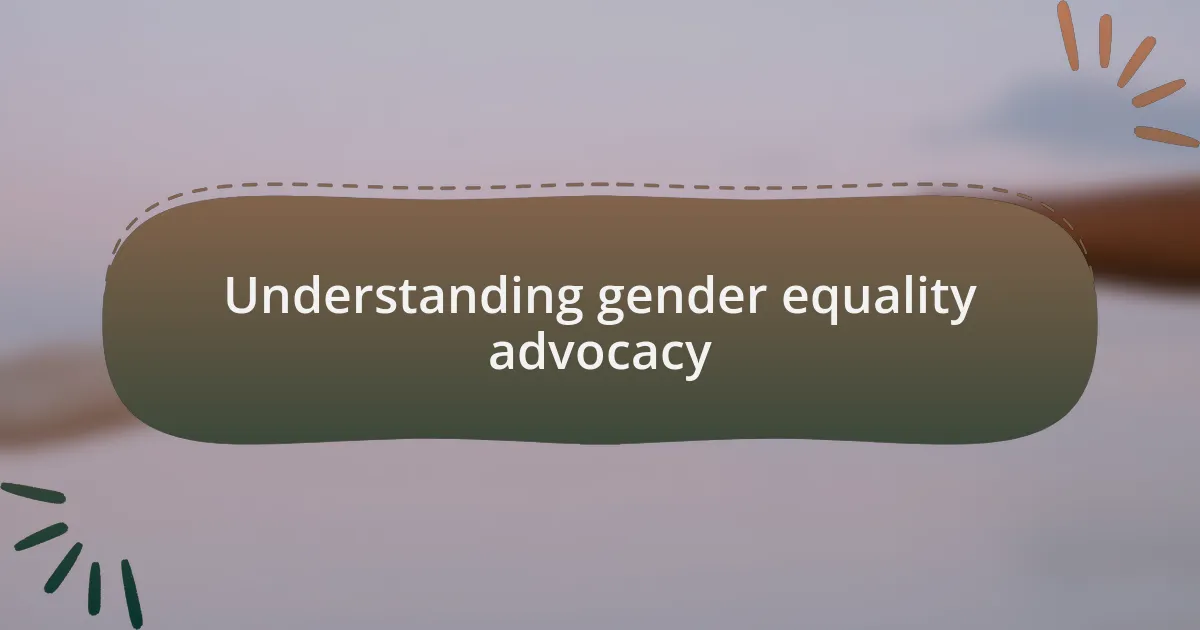
Understanding gender equality advocacy
Gender equality advocacy centers on the belief that everyone, regardless of gender, should have the same rights, opportunities, and access to resources. I remember a moment when I first grasped the weight of this issue: I attended a community meeting where women shared their struggles for equal pay and representation. Witnessing their courage made me realize how deeply entrenched these inequalities are, and I couldn’t help but wonder—why is it that talent and hard work can fall short simply because of gender?
At its core, gender equality advocacy is about dismantling systemic barriers that hinder progress. I encountered this firsthand while volunteering for an organization that aimed to empower young girls through education. The resilience I witnessed in those girls inspired me to ask: how many potential leaders are we losing in the shadows of inequality? Engaging with them helped me see that advocating for equality is not just about policies; it’s about changing mindsets and fostering environments where everyone can thrive.
Advocacy takes many forms, from grassroots campaigns to policy reform. Each approach is crucial in creating sustained change. During a recent workshop, I met individuals from various backgrounds united by a common goal: to amplify unheard voices. Their stories rekindled my commitment to this cause, showing me that every effort counts, no matter how small it may seem. What if each of us took a step, however tiny, toward creating a more equal world? That thought continues to drive my passion for advocacy.
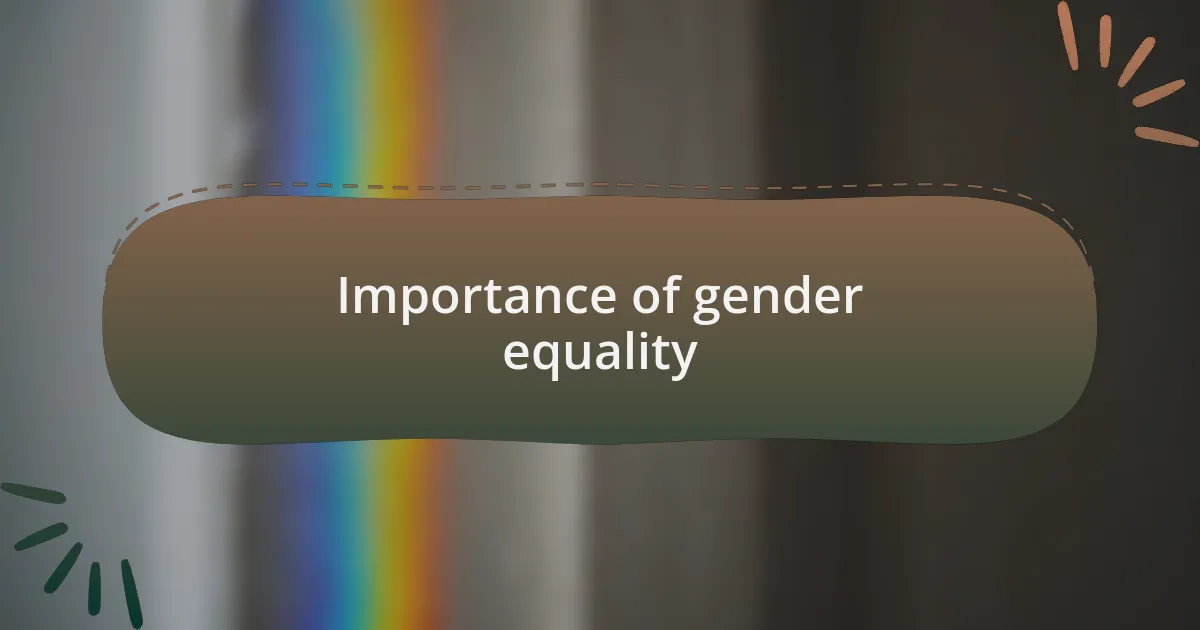
Importance of gender equality
Gender equality is essential for creating a balanced society where everyone has the chance to succeed. In my own experience, I once facilitated a discussion group where both men and women shared their perspectives on workplace challenges. It was eye-opening to see how gender biases can subtly shape career trajectories. Why should opportunities be determined by gender rather than talent and ambition?
When we embrace gender equality, we not only uplift individuals but also foster economic growth and innovation. I recall a project where diverse teams produced more creative solutions simply because varied viewpoints were considered. This made me ponder—how many brilliant ideas have we missed out on due to a lack of gender diversity? Promoting equality opens doors to a wider range of talents, igniting creativity and productivity across all sectors.
Moreover, the emotional impacts of gender equality extend beyond the individual. I remember attending a panel where survivors of gender-based violence spoke of their journeys towards healing and empowerment. Their stories drove home the point that equality is vital for mental and emotional well-being. Isn’t it remarkable that when we champion equality, we not only support individuals but also strengthen communities? This interconnectedness underscores the necessity of this advocacy in our daily lives.
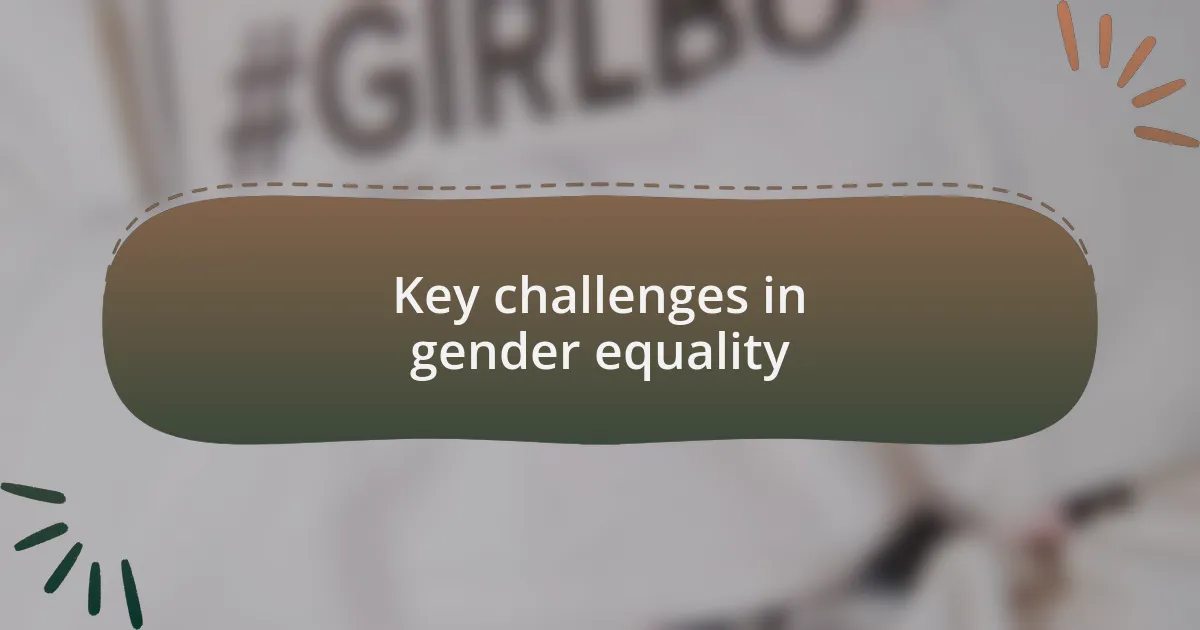
Key challenges in gender equality
One of the most significant challenges in gender equality is the persistence of deeply ingrained societal norms. When I was working on a community project aimed at educating young people about gender roles, I was struck by how many participants felt that certain careers were just “not for them” based solely on their gender. Isn’t it disheartening that backward beliefs can limit potential and inhibit dreams before they’ve even begun?
Another hurdle is the lack of representation in leadership positions. During a workshop I attended, statistics revealed that women hold only a fraction of executive roles, which made me reflect on the importance of role models. If young girls can’t see women in power, how are they supposed to aspire to those positions? It seems that equal representation must be actively pursued, or we risk perpetuating the cycle of inequality.
Additionally, the intersectionality of gender with race, class, and other identities creates complex barriers. I recall a conversation with a colleague who shared her experiences as a woman of color in the workplace, highlighting that the challenges she faced were different and often more intense than those of her white female counterparts. Why must we advocate for equality without recognizing that different paths can lead to drastically different experiences? Understanding these nuances is crucial to making real progress.
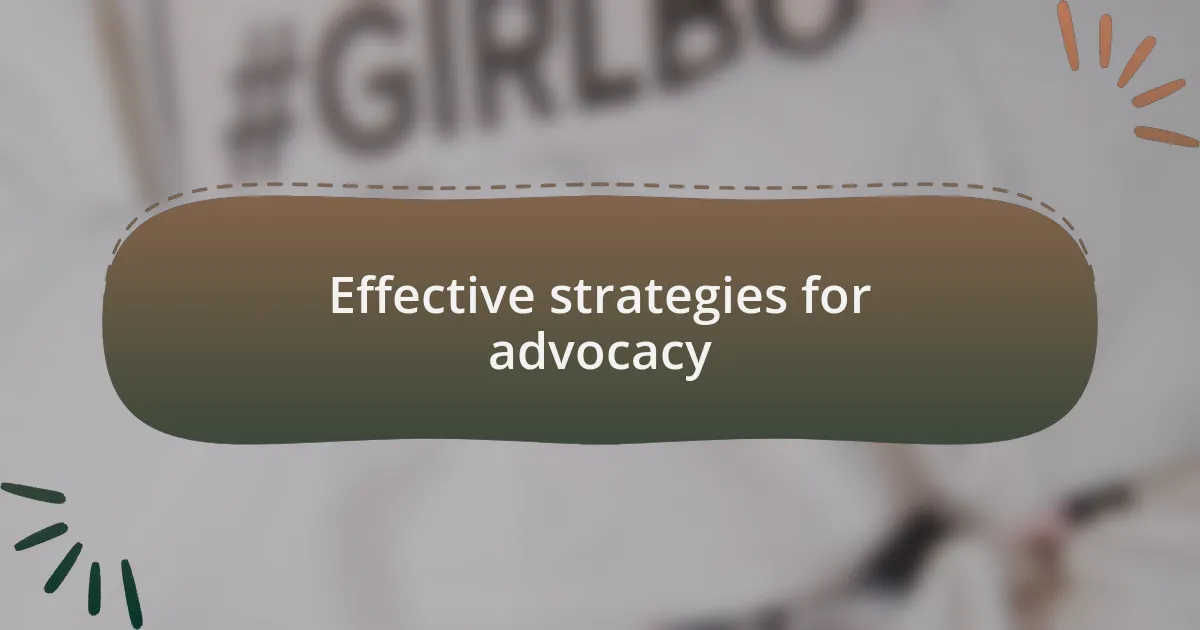
Effective strategies for advocacy
Advocacy for equality can be immensely effective when it’s rooted in storytelling. I remember attending an event where a survivor shared her journey, detailing the struggles she faced due to gender bias. As her story unfolded, the audience visibly reacted, nodding and whispering in empathy. It struck me how powerful personal narratives can shift perspectives and humanize complex issues, creating a connection that mere statistics never could. Isn’t it fascinating how a single story can spark change?
Another strategy I find invaluable is collaboration with diverse groups. In one of my recent projects, I partnered with organizations that focus on intersectionality, bringing together individuals from various backgrounds. This collective approach not only amplified our voice but also enriched our understanding of the multifaceted nature of gender equality. How can we truly champion equality without hearing from those whose experiences differ from our own?
Furthermore, leveraging digital platforms has transformed the landscape of advocacy. I often engage with social media campaigns that call attention to gender-related issues, amplifying messages far beyond my immediate circle. One such campaign encouraged participants to share their own hashtags, creating a wave of stories that fostered solidarity. Could this digital storytelling be the key to reaching those who might otherwise remain uninformed?
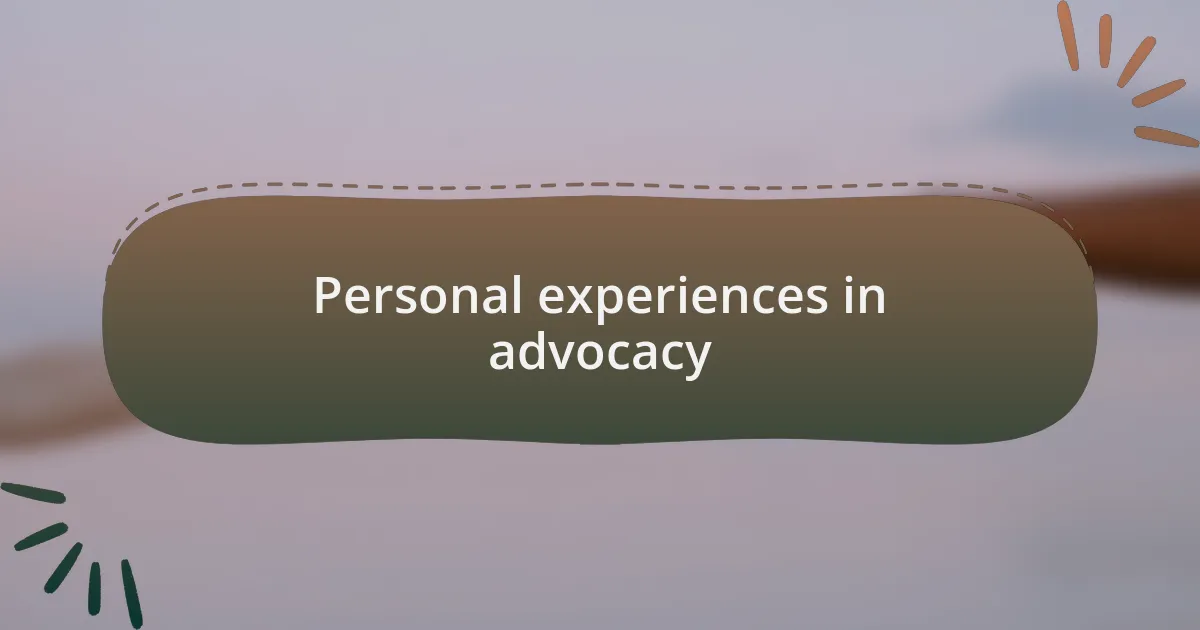
Personal experiences in advocacy
One memorable experience I had in advocacy was at a local community forum where I was invited to speak about gender equality. Standing in front of a diverse audience, I shared a moment from my life when I faced blatant discrimination in the workplace. The energy in the room shifted as I recounted my feelings of frustration and helplessness, and I noticed many nodding along, their expressions reflecting shared struggles. Isn’t it powerful to realize that our individual experiences can resonate with so many others?
During my journey, I’ve also learned the importance of listening actively to those I aim to support. I once facilitated a workshop where participants shared their own stories of inequality—each one more poignant than the last. Each narrative opened my eyes to the nuances of their experiences and made me reconsider my approach to advocacy. How can we truly advocate for others if we don’t first take the time to understand their challenges deeply?
There was a time when I organized a campaign to address workplace harassment, and it wasn’t just about raising awareness; it was a call for change. I reached out to individuals who had experienced harassment and encouraged them to share their stories, but I also prioritized creating a safe space for them. The vulnerability that unfolded during those discussions was profound, highlighting not just the issue itself but also the strength in unity. Isn’t it amazing how providing a safe haven for voices can lead to collective empowerment?
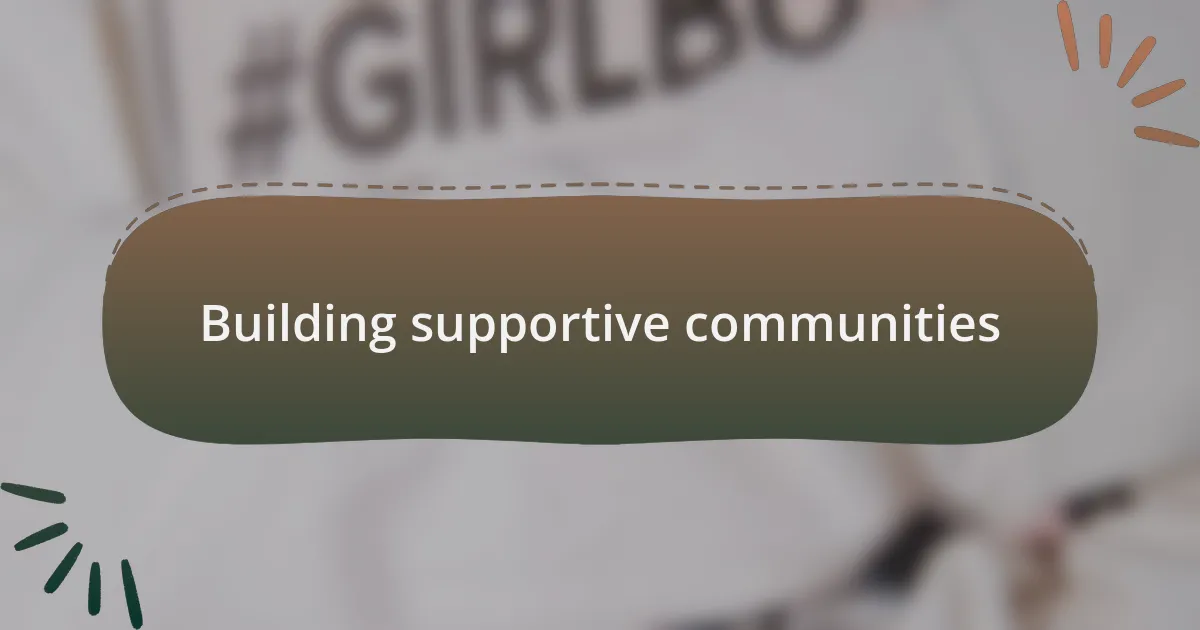
Building supportive communities
Building supportive communities is crucial in fostering a culture of equality. I remember the first time I joined a grassroots organization focused on gender equality. The sense of camaraderie was palpable. We weren’t just a group of advocates; we became a family, sharing our triumphs and struggles. Have you ever felt that kind of connection where you know your voice matters?
In our meetings, we would often highlight our individual experiences, and it struck me how each story enriched our collective mission. One evening, while discussing strategies, a fellow member shared a heartbreaking experience of being silenced at work. As she spoke, I could see the tears welling up in her eyes, reminding us all of the emotional weight we carry. It made me realize that building a supportive community isn’t just about advocacy; it’s about creating a safe space for healing and growth.
Moreover, I’ve found that collaboration amplifies our impact. During a project aimed at empowering young women in our area, we partnered with local schools to host workshops. Watching the transformation in those young girls, as they learned to voice their opinions, was incredibly rewarding. It raised an important question for me: How can we harness the power of community to effect long-lasting change, not just within ourselves, but in the world around us?
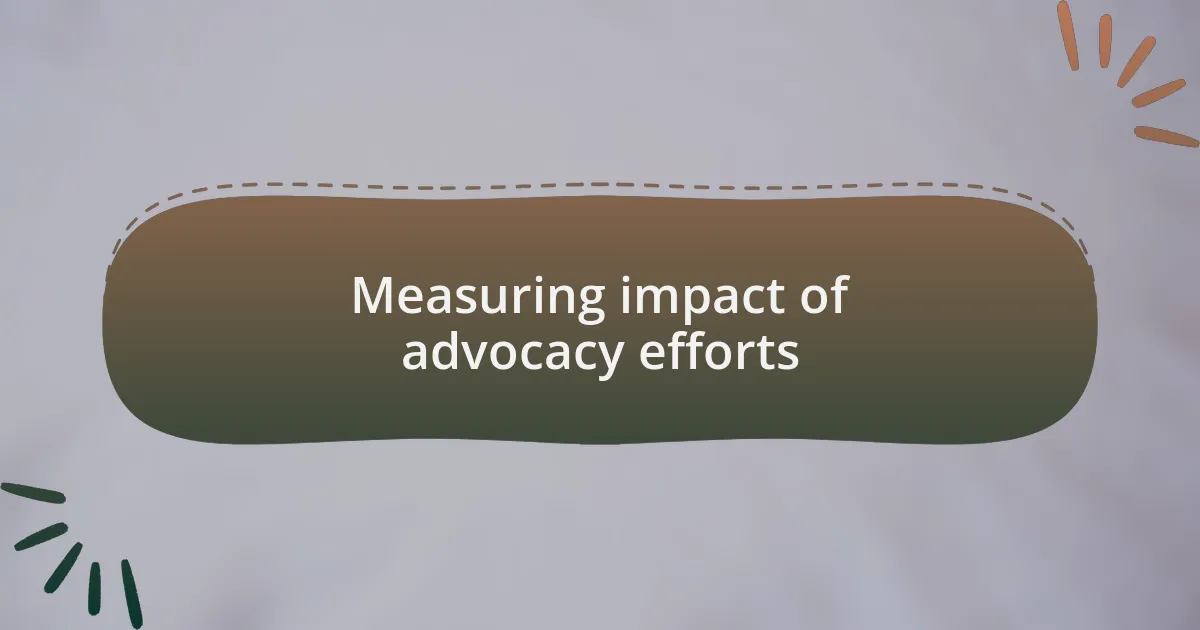
Measuring impact of advocacy efforts
Measuring the impact of advocacy efforts can sometimes feel daunting. I remember leading a campaign where we gathered data before and after our initiatives to assess shifts in community attitudes. The sense of accomplishment I felt when we saw a measurable increase in support for gender equality was indescribable. Have you ever celebrated a moment when your hard work paid off, even in small ways?
One of the most enlightening experiences for me was using surveys to gauge our audience’s understanding of gender issues. Initially, many participants were unaware of the nuances involved. After our outreach, the responses shifted remarkably. An increase in awareness signals that we are moving in the right direction, but it also raises questions: Are we truly connecting with our audience? How do we ensure that our message resonates beyond the numbers?
I’ve also learned that storytelling is a powerful tool in evaluating our efforts. By sharing narratives of individuals who benefitted from our work, we could illustrate changes that statistics alone couldn’t capture. I recall a young woman who spoke passionately about how our mentorship program transformed her confidence. Her words were a palpable reminder that the heart of our impact lies not just in data, but in the real, lived experiences of those we aim to serve.